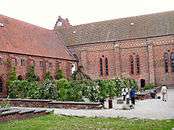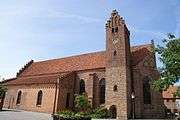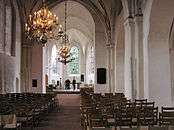Greyfriars Abbey, Ystad
The Abbey in Ystad (Swedish: Klostret i Ystad), sometimes also simply Greyfriars Abbey (Swedish: Gråbrödraklostret) is a medieval former friary in Ystad, Sweden. Together with Vadstena Abbey, it is one of the most well-preserved medieval monasteries in Sweden.[1] It today houses the Museum of the cultural history of Ystad (Swedish: Klostret i Ystad).
 Location within Skåne | |
| Monastery information | |
|---|---|
| Other names | Ystad Abbey |
| Order | Franciscans |
| Established | 1267 |
| Disestablished | 1532 |
| Site | |
| Location | Ystad, Skåne County, Sweden |
| Coordinates | 55°25′51″N 13°49′10″E |
History
According to an inscription from the 14th century, the monastery was founded by a donation by a knight called Holmger and his wife Katarina in 1267 and inaugurated by the Bishop of Reval. From the outset, it belonged to the Franciscan order, who were popularly known as grey friars (hence the name of the monastery), and functioned as a friary for friars. Throughout the Middle Ages several documented donations to the monastery took place.[2]
In 1532, amidst the ongoing reformation in Denmark, the Danish king Frederick I ordered the Franciscans to leave the monastery. They were however not allowed to leave in peace as the citizens of Ystad took the matter in their own hands and forcibly evicted the friars on 24 March 1532. Subsequently, the building was transformed into an almshouse. Little is known of the building's fate during this time, but sometime, probably during the early years of the 1600s, the western and northern wings of the building were pulled down, quite possibly due to a lack of funding. The brick was probably sold as building material and used in the building of some nearby manor or castle.[2]
In 1658, Denmark handed over Ystad and the monastery to Swedish authorities following the Treaty of Roskilde. In 1777, the hospital closed and the premises were taken over by the state-owned akvavit distillery, but as the state abolished its alcohol monopoly in 1786 it became used instead as a granary. In the early 19th century the building was left to decay. In 1877, the building was purchased by the city government and plans both to restore and to pull the building down were ventilated. It was only in 1909, however, that restoration works finally began.[2]
Architecture
The monastery complex consists of three connected buildings: the parish church of St. Peter (the former church of the monastery), the former gatehouse and the one preserved wing originally forming one side of a quadrangle. The buildings are almost exclusively erected in red brick, making the edifice one of the most striking examples in Sweden of Brick Gothic. Surrounding the buildings are a rose garden, laid out in 2002, and a herbal garden, laid out in 1998.[2]
The church of St. Peter
The former church of the monastery is a narrow, rectangular church with whitewashed Gothic groin vaulting and restrained decoration, both on the inside and the exterior. This is typical for Franciscan churches, an outward sign of their pledges of poverty. The nave is flanked by a single aisle to the south. The windows are high and narrow Gothic windows. A bell tower that reaches above the rest of the church is located to the east of the aisle. Externally, the western façade is decorated with blind arches.[2]
The gatehouse
The two-storey gatehouse dates from sometime between the late 14th century and the middle of the 15th, a period in which the monastery was greatly expanded. It originally connected the church with the western wing, now destroyed, which probably housed guest rooms.[2]
The monastery
The one surviving wing of the monastery proper is a rectangular building with a cloister facing the former quadrangle. The building has a half-timbered extension protruding to the north-east, and richly decorated crow-stepped gables. The windows are typically pointed undecorated Gothic windows.[2]
Gallery
 Exterior view from the north-west
Exterior view from the north-west Exterior view from the south-east
Exterior view from the south-east- Exterior view from the north-east
 Interior view of the church
Interior view of the church
See also
- List of Brick Gothic buildings
- List of monasteries in Sweden
- St. Mary's Church, Ystad
References
- "The Monastery in Ystad". Culturalnarrative.com. Retrieved April 27, 2013.
- Lund, Carola (2006). Klostret i Ystad (in Swedish). Malmö kulturmiljö, enheten för kulturmiljövård.
External links
- Official webpage (in Swedish)

